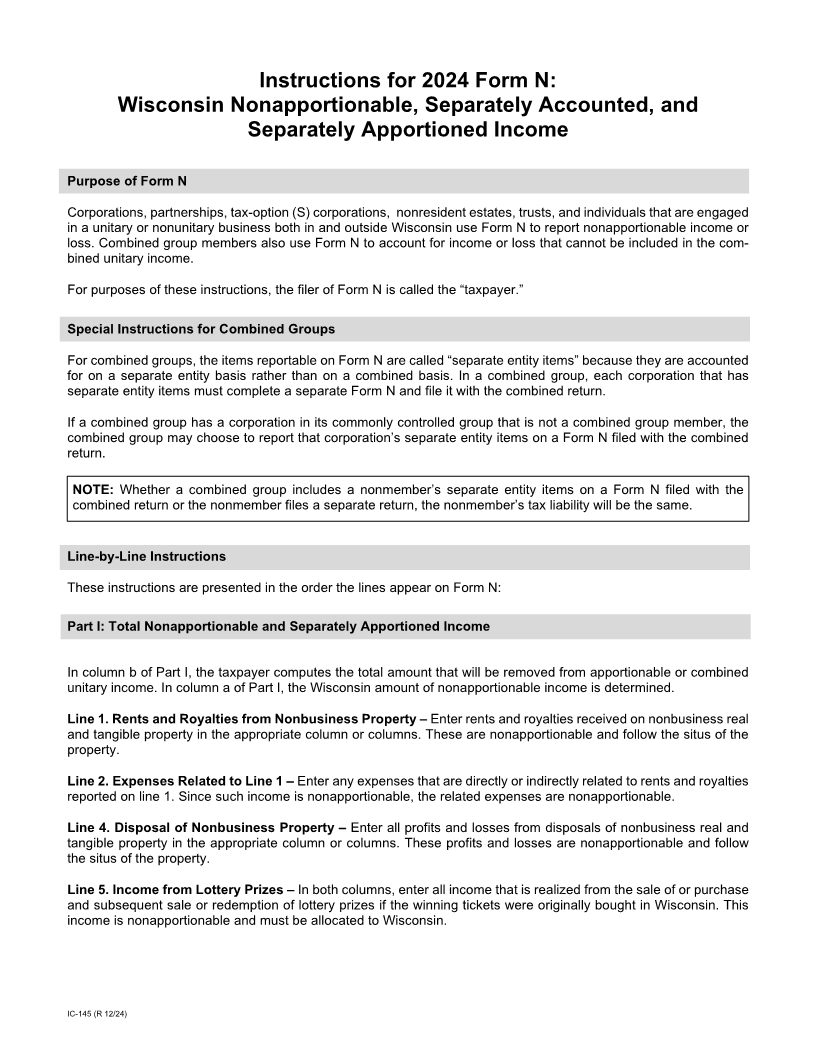
Enlarge image
Instructions for 2024 Form N:
Wisconsin Nonapportionable, Separately Accounted, and
Separately Apportioned Income
Purpose of Form N
Corporations, partnerships, tax-option (S) corporations, nonresident estates, trusts, and individuals that are engaged
in a unitary or nonunitary business both in and outside Wisconsin use Form N to report nonapportionable income or
loss. Combined group members also use Form N to account for income or loss that cannot be included in the com-
bined unitary income.
For purposes of these instructions, the filer of Form N is called the “taxpayer.”
Special Instructions for Combined Groups
For combined groups, the items reportable on Form N are called “separate entity items” because they are accounted
for on a separate entity basis rather than on a combined basis. In a combined group, each corporation that has
separate entity items must complete a separate Form N and file it with the combined return.
If a combined group has a corporation in its commonly controlled group that is not a combined group member, the
combined group may choose to report that corporation’s separate entity items on a Form N filed with the combined
return.
NOTE: Whether a combined group includes a nonmember’s separate entity items on a Form N filed with the
combined return or the nonmember files a separate return, the nonmember’s tax liability will be the same.
Line-by-Line Instructions
These instructions are presented in the order the lines appear on Form N:
Part I: Total Nonapportionable and Separately Apportioned Income
In column b of Part I, the taxpayer computes the total amount that will be removed from apportionable or combined
unitary income. In column a of Part I, the Wisconsin amount of nonapportionable income is determined.
Line 1. Rents and Royalties from Nonbusiness Property – Enter rents and royalties received on nonbusiness real
and tangible property in the appropriate column or columns. These are nonapportionable and follow the situs of the
property.
Line 2. Expenses Related to Line 1 – Enter any expenses that are directly or indirectly related to rents and royalties
reported on line 1. Since such income is nonapportionable, the related expenses are nonapportionable.
Line 4. Disposal of Nonbusiness Property – Enter all profits and losses from disposals of nonbusiness real and
tangible property in the appropriate column or columns. These profits and losses are nonapportionable and follow
the situs of the property.
Line 5. Income from Lottery Prizes – In both columns, enter all income that is realized from the sale of or purchase
and subsequent sale or redemption of lottery prizes if the winning tickets were originally bought in Wisconsin. This
income is nonapportionable and must be allocated to Wisconsin.
IC-145 (R 12/24)




